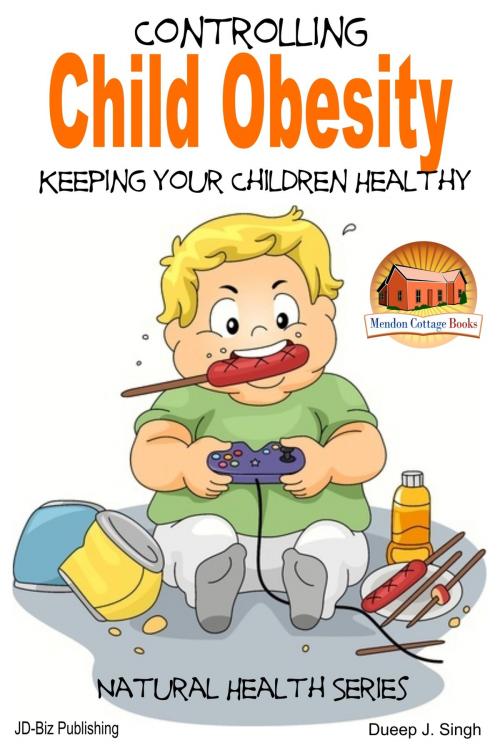Controlling Child Obesity: Keeping Your Children Healthy
Nonfiction, Health & Well Being, Health, Nutrition & Diet, Diets| Author: | Dueep J. Singh | ISBN: | 9781311068446 |
| Publisher: | Mendon Cottage Books | Publication: | January 3, 2015 |
| Imprint: | Smashwords Edition | Language: | English |
| Author: | Dueep J. Singh |
| ISBN: | 9781311068446 |
| Publisher: | Mendon Cottage Books |
| Publication: | January 3, 2015 |
| Imprint: | Smashwords Edition |
| Language: | English |
Controlling Child Obesity - Keeping Your Children Healthy
Table of Contents
Introduction
Reasons for obesity
Side effects of Childhood Obesity
Does Your Child Have a Genuine Weight Problem?
How to prevent Obesity in Your Child
Healthy Convenience Food Options
Homemade Burger Patties
Homemade chicken Nuggets
Chips
Ice cream
Conclusion
Publisher
Introduction
Did you know that in the last 30 years, the childhood obesity cases in children have more than doubled and more than quadrupled, in teenagers and adolescents, in the USA alone?
7% of children were considered to be obese in 1980. In 2012, that percentage had increased to 18%. In the same manner, teenage obesity had increased from 5% to 21% in that particular time period.
What is the difference between obesity and overweight? Overweight means that our body has extra body weight, due to water, bone, fat, muscle, or any of these combined factors for a particular and given height. On the other hand, obesity is concerned with just extra body fat.
Millennium ago, the idea of children being obese was a rather rare phenomenon. They may have been overweight, because of lack of physical exercise and eating lots of food indiscriminately. But they were not obese, because they were not genetically conditioned to be so. Also, sedentary lifestyles at that time was not encouraged in children because, since childhood, they were trained to do hard physical labor, which they would continue for the rest of their lives.
In many parts of the world, there are still societies which equate being fat and well-rounded with being prosperous. That is the reason why even now, mothers still stuff up their children, with lots and lots of food, so that people do not blame them for “starving their children” because they are so thin.
How did this attitude of society come into being? We have to go back millenniums ago, when man was still struggling to survive. That is when it was not so easy for him to get enough of food to feed his large family. This is the reason why plenty of his children stayed hungry unless they could forage for themselves.
It was only in a comparatively prosperous family, that they could get enough of food to eat, in order to get “fat.” That is when fat became synonymous with prosperity. Kings and emperors were never shown to be lean, slim and thin, unless they were warriors and were in battle worthy conditions, in wall paintings or rock carvings. They had this bit of a paunch.
This was to show that they had enough of food to eat and to eat heartily, so that they could get fat.
Controlling Child Obesity - Keeping Your Children Healthy
Table of Contents
Introduction
Reasons for obesity
Side effects of Childhood Obesity
Does Your Child Have a Genuine Weight Problem?
How to prevent Obesity in Your Child
Healthy Convenience Food Options
Homemade Burger Patties
Homemade chicken Nuggets
Chips
Ice cream
Conclusion
Publisher
Introduction
Did you know that in the last 30 years, the childhood obesity cases in children have more than doubled and more than quadrupled, in teenagers and adolescents, in the USA alone?
7% of children were considered to be obese in 1980. In 2012, that percentage had increased to 18%. In the same manner, teenage obesity had increased from 5% to 21% in that particular time period.
What is the difference between obesity and overweight? Overweight means that our body has extra body weight, due to water, bone, fat, muscle, or any of these combined factors for a particular and given height. On the other hand, obesity is concerned with just extra body fat.
Millennium ago, the idea of children being obese was a rather rare phenomenon. They may have been overweight, because of lack of physical exercise and eating lots of food indiscriminately. But they were not obese, because they were not genetically conditioned to be so. Also, sedentary lifestyles at that time was not encouraged in children because, since childhood, they were trained to do hard physical labor, which they would continue for the rest of their lives.
In many parts of the world, there are still societies which equate being fat and well-rounded with being prosperous. That is the reason why even now, mothers still stuff up their children, with lots and lots of food, so that people do not blame them for “starving their children” because they are so thin.
How did this attitude of society come into being? We have to go back millenniums ago, when man was still struggling to survive. That is when it was not so easy for him to get enough of food to feed his large family. This is the reason why plenty of his children stayed hungry unless they could forage for themselves.
It was only in a comparatively prosperous family, that they could get enough of food to eat, in order to get “fat.” That is when fat became synonymous with prosperity. Kings and emperors were never shown to be lean, slim and thin, unless they were warriors and were in battle worthy conditions, in wall paintings or rock carvings. They had this bit of a paunch.
This was to show that they had enough of food to eat and to eat heartily, so that they could get fat.















